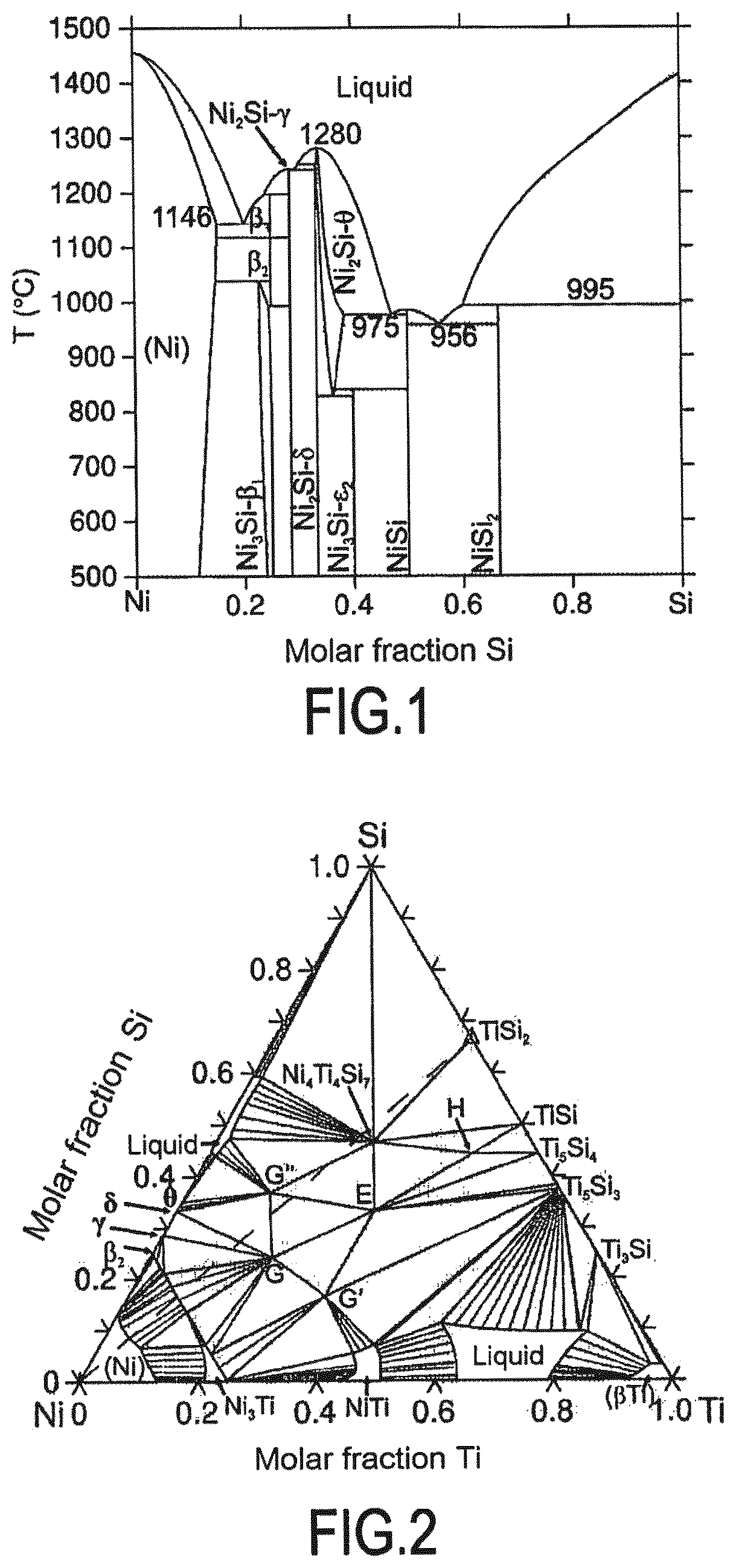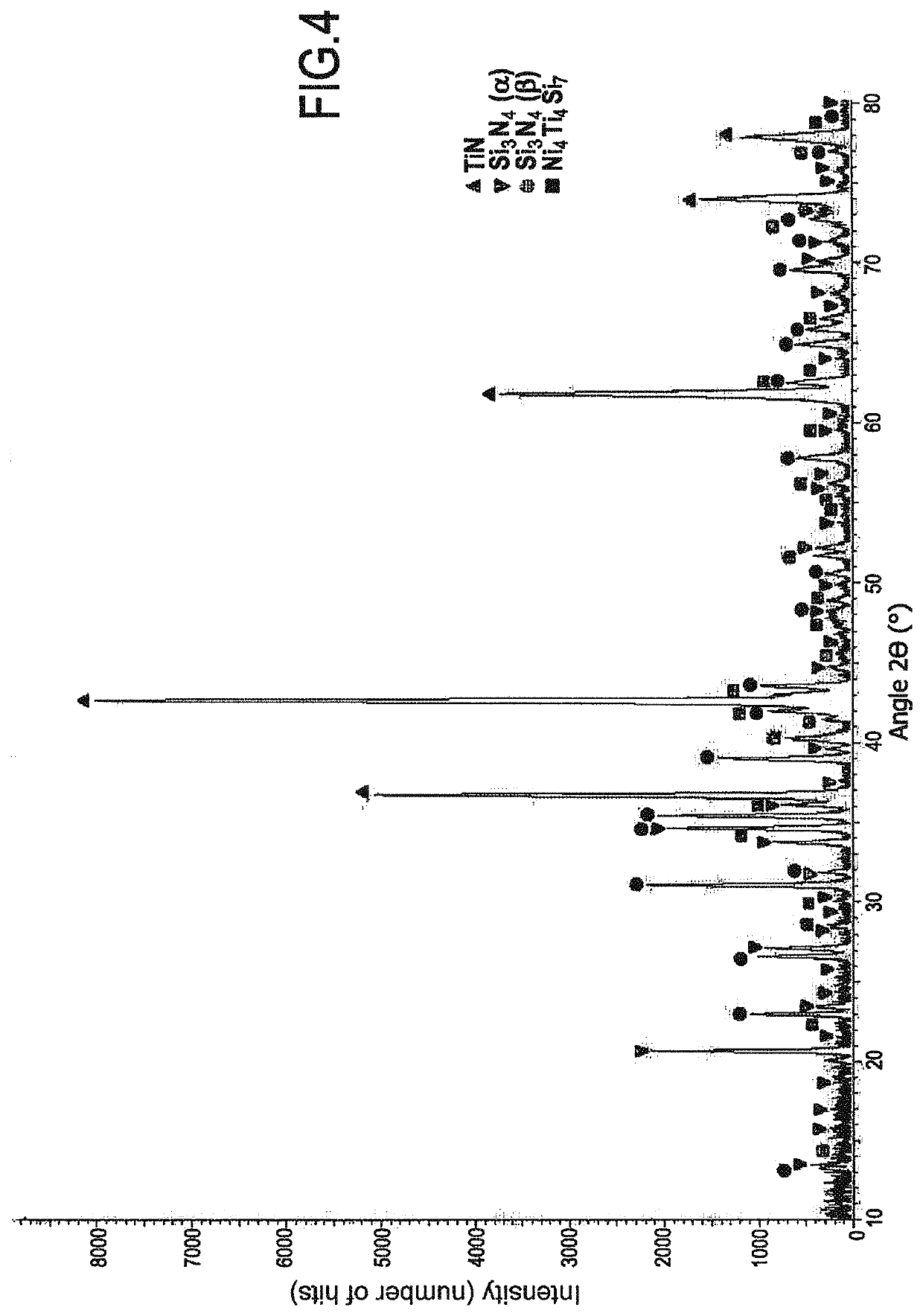Method of fabricating a ceramic from a chemical reaction
a chemical reaction and ceramic technology, applied in the direction of engines, machines/engines, mechanical equipment, etc., can solve the problems of high cost of methods, difficult industrial production, and long fabrication duration of cmc parts
- Summary
- Abstract
- Description
- Claims
- Application Information
AI Technical Summary
Benefits of technology
Problems solved by technology
Method used
Image
Examples
example 1 (
Invention)
[0084]FIGS. 3A to 3C are photographs showing the material obtained after converting a sample having an initial composition of 90 at % TiSi2+10 at % Ni by treatment under normal pressure with N2 at 1100° C. for 40 hours (h). The phases present at the end of the treatment were TiN, Si3N4, and Ni4Ti4Si7 (see FIG. 4). It should be observed that at the end of the treatment, free silicon and residual TiSi2 were absent. This reaction was accompanied by an increase in volume of about 50%.
[0085]FIGS. 5B and 5C are photographs showing in particular a matrix obtained by converting an infiltrated powder (d50=300 nanometers (nm)) having an initial composition of 90 at % TiSi2+10 at % Ni treated under normal pressure with N2 at 1100° C. for 40 h within a fiber preform. The phases formed were identical to those described above (TiN, Si3N4, and Ni4Ti4Si7). No reaction was observable between the powder and the Nicalon® fibers coated in a PyC / SiC interphase.
[0086]Likewise, FIG. 5A also show...
example 4
[0107]Pellets of ZrSi2 were nitrided for 40 h under normal pressure of dinitrogen at a temperature of 1100° C.
[0108]When 10 at % of nickel were added to the mixture, and after 40 h of nitriding, the majority phases were ZrN and Si3N4. The presence of ZrSi2, ZrSi2Si, and NiZr was observed in the minority. The presence of free silicon was not observed.
[0109]Without adding nickel (not the invention), the majority phases were ZrN and ZrSi2 after 40 h of nitriding. Si3N4 was detected, but it constituted a minority phase. Free silicon was also detected.
[0110]Adding nickel thus facilitated nitriding of the metallic disilicide ZrSi2 even at a relatively low working temperature of 1100° C.
example 5
[0111]Pellets of ZrSi2 were nitrided for 40 h under normal pressure of dinitrogen at a temperature of 1100° C.
[0112]When a powder of AS13 alloy was added at 10 at %, and after 40 h of nitriding, the majority phases were ZrN, Si3N4, and ZrSi2. The presence of a minimum quantity of free silicon was observed.
[0113]Without adding the AS13 powder, and after 40 h of nitriding, the majority phases were ZrN and ZrSi2, with Si3N4, being observed in the minority. Free silicon was also detected.
[0114]Adding an aluminum alloy to the silicon thus facilitated nitriding the metallic disilicide ZrSi2 even at a relatively low working temperature of 1100° C.
PUM
| Property | Measurement | Unit |
|---|---|---|
| pressure | aaaaa | aaaaa |
| temperature | aaaaa | aaaaa |
| temperature | aaaaa | aaaaa |
Abstract
Description
Claims
Application Information
 Login to View More
Login to View More - R&D
- Intellectual Property
- Life Sciences
- Materials
- Tech Scout
- Unparalleled Data Quality
- Higher Quality Content
- 60% Fewer Hallucinations
Browse by: Latest US Patents, China's latest patents, Technical Efficacy Thesaurus, Application Domain, Technology Topic, Popular Technical Reports.
© 2025 PatSnap. All rights reserved.Legal|Privacy policy|Modern Slavery Act Transparency Statement|Sitemap|About US| Contact US: help@patsnap.com



